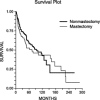Primary breast lymphoma: the role of mastectomy and the importance of lymph node status
- PMID: 17457172
- PMCID: PMC1877073
- DOI: 10.1097/01.sla.0000254418.90192.59
Primary breast lymphoma: the role of mastectomy and the importance of lymph node status
Abstract
Objective: To construct and analyze a database comprised of all reported cases of primary breast lymphoma (PBL) that include treatment and follow-up information published during the last 3 decades.
Summary background data: PBL accounts for 0.4% of breast malignancies and 2% of extranodal lymphomas. Surgical therapy has varied from biopsy to radical mastectomy. Chemotherapy and radiation therapy have been used as adjuvant or primary therapy. A standard consensus treatment of PBL is not available.
Methods: We reviewed all published PBL reports from June 1972 to March 2005. A database was compiled by abstracting individual patient information, limiting our study to those reports that contained specific treatment and outcome data. Patient demographics such as survival, recurrence, and time to follow-up were recorded, in addition to surgical, radiation, and/or chemotherapy treatment(s).
Results: We found 465 acceptable patients reported in 92 publications. Age range was 17 to 95 years (mean, 54 years). Mean tumor size was 3.5 cm. Diffuse large cell (B) lymphoma was the most common histologic diagnosis (53%). Disease-free survival was 44.5% overall. Follow-up ranged from one to 288 months (mean, 48 months). Treatment by mastectomy offered no survival benefit or protection from recurrence. Treatment that included radiation therapy in stage I patients (node negative) showed benefit in both survival and recurrence rates. Treatment that included chemotherapy in stage II patients (node positive) showed benefit in both survival and recurrence rates. Histologic tumor grade predicted survival.
Conclusions: Mastectomy offers no benefit in the treatment of PBL. Nodal status predicts outcome and guides optimal use of radiation and chemotherapy.
Figures





Similar articles
-
Analysis of 31 cases of primary breast lymphoma: the effect of nodal involvement and microvascular density.Clin Lymphoma Myeloma Leuk. 2011 Feb;11(1):33-7. doi: 10.3816/CLML.2011.n.004. Clin Lymphoma Myeloma Leuk. 2011. PMID: 21454188
-
[Primary breast lymphoma--a report of 27 cases with literature review].Ai Zheng. 2007 Jan;26(1):84-9. Ai Zheng. 2007. PMID: 17222374 Review. Chinese.
-
[Clinical analysis of resectable breast cancer: a report of 6 263 cases].Ai Zheng. 2005 Mar;24(3):327-31. Ai Zheng. 2005. PMID: 15757535 Chinese.
-
Survival benefit of post-mastectomy radiotherapy in breast carcinoma patients with T1-2 tumor and 1-3 axillary lymph node(s) metastasis.Jpn J Clin Oncol. 2012 Jul;42(7):601-8. doi: 10.1093/jjco/hys052. Epub 2012 Apr 17. Jpn J Clin Oncol. 2012. PMID: 22511807
-
Low risk of locoregional recurrence of primary breast carcinoma after treatment with a modification of the Halsted radical mastectomy and selective use of radiotherapy.Cancer. 1999 Apr 15;85(8):1773-81. Cancer. 1999. PMID: 10223572 Review.
Cited by
-
Primary breast lymphoma in males: Incidence, demographics, prognostic factors, survival, and comparisons with females.Front Surg. 2022 Aug 25;9:984497. doi: 10.3389/fsurg.2022.984497. eCollection 2022. Front Surg. 2022. PMID: 36090327 Free PMC article.
-
Marginal zone lymphoma of the breast-A diminished role for surgery.Int J Surg Case Rep. 2016;25:4-6. doi: 10.1016/j.ijscr.2016.05.041. Epub 2016 Jun 2. Int J Surg Case Rep. 2016. PMID: 27285277 Free PMC article.
-
Primary breast peripheral T-cell lymphoma not otherwise specified: report of a case.Surg Today. 2015 Jan;45(1):115-20. doi: 10.1007/s00595-013-0808-x. Epub 2014 Jan 7. Surg Today. 2015. PMID: 24395027 Free PMC article.
-
Primary breast diffuse large B cell lymphoma - report of 6 cases from South India with review of literature.Indian J Surg Oncol. 2013 Dec;4(4):368-73. doi: 10.1007/s13193-013-0269-0. Epub 2013 Oct 5. Indian J Surg Oncol. 2013. PMID: 24426760 Free PMC article.
-
MRI features of breast lymphoma: preliminary experience in seven cases.Diagn Interv Radiol. 2015 Nov-Dec;21(6):441-7. doi: 10.5152/dir.2015.14534. Diagn Interv Radiol. 2015. PMID: 26380896 Free PMC article.
References
-
- Kim SH, Ezekiel MP, Kim RY. Primary lymphoma of the breast. Am J Clin Oncol. 1999;22:381–383. - PubMed
-
- Shapiro CM, Mansur D. Bilateral primary breast lymphoma. Am J Clin Oncol. 2001;24:85–86. - PubMed
-
- Dao AH, Adkins RB, Glick AD. Malignant lymphoma of the breast: a review of 13 cases. Am Surg. 1992;58:792–796. - PubMed
-
- Zack RJ, Trevisan SG, Gupta M. Primary breast lymphoma originating in a benign intramammary lymph node. AJR Am J Roentgenol. 2001;177:177–178. - PubMed
-
- Wiseman C, Liao KT. Primary lymphoma of the breast. Cancer. 1972;29:1705–1712. - PubMed
MeSH terms
LinkOut - more resources
Full Text Sources
Medical

